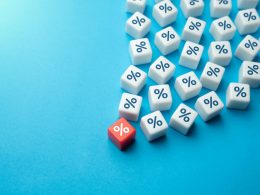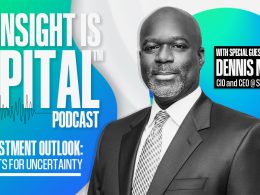by Shannon L. Saccocia, CFA, Chief Investment Officer—Private Wealth, Neuberger Berman
Amid the pile of unhelpful U.S. economic data released recently, the combination of simmering inflation, weakening GDP growth and flagging consumer confidence stands out.
First-quarter growth at 1.6% undershot expectations by almost a percentage point. The Conference Board’s Consumer Confidence Index plummeted to a level last seen in summer 2022, when energy prices were soaring and the U.S. Federal Reserve was throwing 75-basis-point rate hikes onto the flames of inflation.
Today, inflation is again troubling the Fed. Investors are now priced for just one rate cut in 2024, at best, and the consensus sees this as a major reason for consumer pessimism.
But what if the prospect of higher rates for longer turns out to be a positive for consumer spending? That sounds counterintuitive until you look at the U.S. housing market.
Tumbleweed
Superficially, that market does not seem like a hotbed of activity.
Existing home sales are down some 25 – 30% from pre-pandemic levels, according to the National Association of Realtors (NAR). That decline is closely echoed by the Mortgage Bankers Association of America (MBA) Purchase Index, which measures mortgage applications with refinancings and other nonpurchase loans stripped out.
Both measures started to slide during 2022, revealing a clear story: As interest rates surged, potential homebuyers sat on the sidelines to await the return of cheaper mortgages, leaving the housing market to be overrun by tumbleweed.
The Fed rate remains above 5%. The MBA average 30-year mortgage rate climbed back above 7% in April, and for the first time it is cheaper to rent than to buy across all 50 of the largest metropolitan areas in the U.S.—almost 40% cheaper, according to financial products comparison site Bankrate.
So, why would anyone anticipate a housing market rebound?
Homebuyer Holdouts Nearing Capitulation
The answer is that the psychology of the housing market can change just like the psychology of the bond market. Investors have priced for higher rates for longer and, in our view, there’s no reason to assume that potential homebuyers haven’t made the same adjustment.
Six months ago, the calculation is likely to have been, “If I wait another year, my mortgage probably won’t be the 3% I’d have gotten in 2021, but it might be more like 4 – 5%.” Today, 6%-plus looks nailed on for the foreseeable future. In the meantime, house prices are up another 3%.
It is possible that a tipping point was reached in the fourth quarter of last year, when the MBA Purchase Index might have bottomed out. Indeed, monthly activity throughout 2023 was fairly stable; it was in 2022, when rates were rising, that demand for new loans really dried up.
We believe the last homebuyer holdouts may be nearing capitulation.
The Millennial-Homebuyer Wave
Finally, it’s important to consider who these potential homebuyers are. The answer, increasingly, is Millennials.
For a long time, the assumption was that Millennials would never buy their own homes. They were saddled with too much student debt, they didn’t want to take the long-term financial risk of a mortgage, they were less likely to form households.
It turns out the home-owning culture of America is more deeply ingrained than that. Millennials appear to be doing just what their forebears did, only a little later in life.
More than half of Millennials were homeowners by 2022, according to an analysis of U.S. census data by apartment search website RentCafe. And time is getting on for the rest of them: The median Millennial came into the pandemic turning 30, but is now starting to think about life as a 40-something. Sure enough, more and more are taking the homebuying plunge: According to the NAR, last month they surpassed baby boomers as the largest demographic group of homebuyers in the U.S., at 38% of the market—up rapidly from just 28% last year.
Confounding Expectations
This is potentially impactful for the wider economy.
It could provide fresh impetus to rising U.S. house prices, which then feed into broad wealth effects and higher municipal revenues.
And because we are talking mostly about Millennial first-time buyers, we are also talking about new demand for consumer durables and other household goods, as well as home improvement goods and services. In addition, this would be a wave of consumers able to borrow against home equity for the first time, at cheaper rates than credit-card debt.
Consumer confidence surveys may be unearthing some caution at the moment. Nonetheless, U.S. consumers have so far weathered high interest rates better than most economists had expected. If the acceptance of higher rates for longer releases a wave of pent-up homebuying, perhaps they will continue to confound those expectations.
*****
In Case You Missed It
- S&P Case-Shiller Home Price Index: February home prices increased 0.9% month-over-month and increased 7.3% year-over-year (NSA); +0.6% month-over-month (SA)
- U.S. Consumer Confidence: -6.1 to 97.0 in April
- Eurozone Q1 GDP (Preliminary): +0.3% quarter-over-quarter
- Eurozone Consumer Price Index (Flash): +2.4% year-over-year in April
- FOMC Meeting: The Federal Reserve held interest rates steady
- ISM Manufacturing Index: -1.1 to 49.2 in April
- U.S. Employment Report: Nonfarm payrolls increased 175k and the unemployment rate increased to 3.9% in April
- ISM Services Index: -2.0 to 49.4 in April
What to Watch For
-
- Monday, May 6:
- Eurozone Producer Price Index
- Friday, May 10:
- University of Michigan Consumer Sentiment
- China Consumer Price Index
- China Producer Price Index
- Monday, May 6:
Investment Strategy Team
Copyright © Neuberger Berman
















